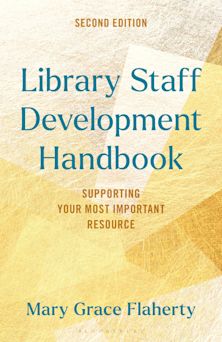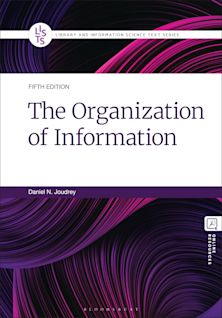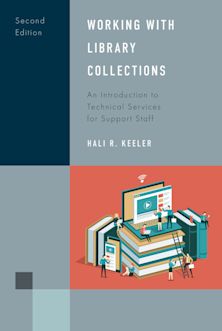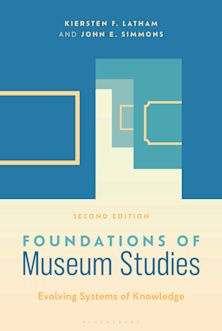Introduction to the Library and Information Professions
- Textbook
Introduction to the Library and Information Professions
- Textbook
Description
This comprehensive book prepares readers for a changing profession in the library and information field, presenting a holistic approach that examines theories and models and utilizes creative problem-solving strategies.
In this rapidly changing, knowledge-based society, library and information professionals require a broad understanding of the profession. Introduction to the Library and Information Professions, Second Edition presents a toolbox of models that enable this essential understanding for undergraduate and graduate students in library and information science programs as well as practicing professionals seeking continuing education. The materials in this second edition reflect the latest trends in the library and information profession, including services and issues that stem from new advances in technology.
The authors present "big picture" information that will allow readers to better plan and implement client-entered services, discussing topics such as the life cycle of information, the role of library and information professionals as change agents, models of information transfer, the national information infrastructure, and important trends and developments. The contents provide readers with clear guidance and a carefully explained rationale for lifelong careers as information professionals.
Table of Contents
Chapter 1: Introduction: Purpose and Objectives of This Book
Chapter Overview
Why Read This Book?
The Intended Audience
Scope of the Book
The Role of Professionals
The Value of Theory
Theory in the Information Professions Today
Theory and Its Uses in Professional Service
Defining Terms
Information and Communication Professions: Convergence and Divergences
Similarities and Differences among the Information Professions
Characteristics of a Profession
Library Technicians and Library Assistants
Conclusion
References
Chapter 2: Creation, Diffusion, and Utilization of Knowledge
Chapter Overview
Introduction
Information and Data
Knowledge
Creation of Knowledge
Dissemination
Diffusion
Utilization
Change and the Evolution of Professions
A Model for Explaining the Creation, Diffusion, and Utilization of Knowledge
Creating New Knowledge
Diffusion of Knowledge
Public Policy
Role of Professions in the Utilization of Knowledge
Implications for Information Professionals
Summary
References
Chapter 3: The Role of Professionals as Change Agents
The Impact of Change on Society
Categories of Change
The Paradigm Shift in Western Society
The Paradigm Shift in Disciplines and Professions
Paradigm Shift in the Information Professions
Levels of User-Centered Services
Conclusion
References
Chapter 4: The Science Supporting the Information Professions
Chapter Overview
The Importance of Theory to Professionals
Levels of Theory
Characteristics Common to the Information Professions
The Science of the Information Professions
Policy and Environmental Context
Conclusion
References
Chapter 5: Information Transfer in the Information Professions
Chapter Overview
Introduction to Information Transfer
A Closer Look at Information Transfer
Information Professions and Information Transfer
A Model for Managing an Information Utility
Community Information Infrastructure
Conclusion
References
Chapter 6: The Cycle of Professional Service
Chapter Overview
Role of the Professional
The Diagnostic Process
Diagnosing Information Use Behaviors
Theory Base for Diagnosis
Implications for Practitioners
The Environmental Context
Community Analysis
Putting the Information to Work
Conclusion
References
Chapter 7: The Information Infrastructure
Chapter Overview
Definition of "Information Infrastructure"
A Model for Studying the Information Infrastructure: The Transportation Infrastructure
Elements of the Information Infrastructure
A Model for Analyzing the Information Infrastructure
A Model for the Technology and Information Infrastructure
Role of Information Professionals
Conclusion
References
Chapter 8: The Processes and Functions of Information Professionals
Chapter Overview
The Importance of Customization
The Processes of Building a Collection of Resources
The Functions of Information Agencies
Levels of Service
Putting It All Together: The Role of the Professional
References
Chapter 9: The Infrastructure of the Information Professions
Chapter Overview
Characteristics of a Profession
History
Body of Knowledge
Professional Associations
Literature of the Field
Professional Education
Accreditation
Guidelines for Service
Code of Ethics
Public Recognition
Taxonomy of the Information Professions
Conclusion
Chapter 10: Trends and Issues
Chapter Overview
Introduction
Information Infrastructure Issues
Issues in Library/Information Education
Recent Studies in LIS Education
Conclusion
References
Appendix A: Codes of Ethics
Appendix B: Professional Organizations
Appendix C: Professional Journals
Bibliography
Index
Product details
| Published | 11 Jun 2013 |
|---|---|
| Format | Ebook (PDF) |
| Edition | 2nd |
| Extent | 216 |
| ISBN | 9781610691581 |
| Imprint | Libraries Unlimited |
| Publisher | Bloomsbury Publishing |
Reviews

ONLINE RESOURCES
Bloomsbury Collections
This book is available on Bloomsbury Collections where your library has access.


































